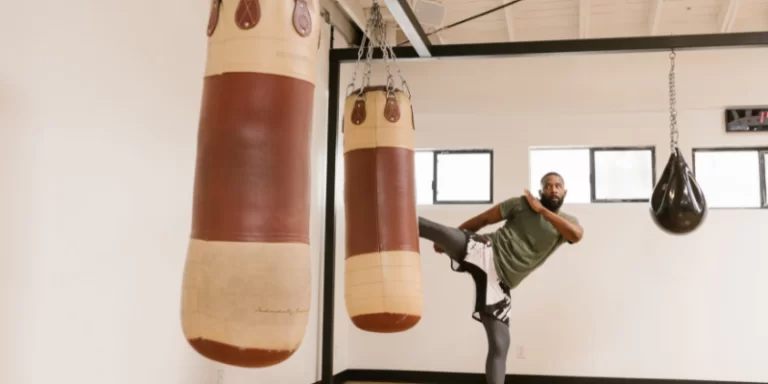11 Different Types oF Kicks in Kickboxing & Their Benefits
In kickboxing, kicks are like your long range weapons. There are lots of different ways to learn kicks in kickboxing, and it varies depending on the style you are using. Some of the basic kicks in kickboxing include the roundhouse body kick, high kick, and leg/low kick. If you are more advanced, you might try fancier kicks like the spinning back kick, axe kick, jump kick, flying kick, and even the cartwheel kick. These kicks are like the special moves in kickboxing.
In kickboxing, most of the kicks are used as attacks, to hit your opponent. You can use it to push your opponent back or to stop them from getting too close. You can aim it at their area between the ribs and the stomach, their abdomen, or even their face. So, it is a kick that can disrupt your opponent’s rhythm and keep them at bay, but you can also use it as a surprise attack if needed.
Kicks in kickboxing can target various parts of the body like the ribcage, arms, head, neck, legs, and even the back. However, it is important to note that in most fighting sports, direct kicks to the groin area are not allowed. In this post we will cover the types of Kick in kickboxing.
Is Kicking better than Punching?
When it comes to kicking and punching in kickboxing, there isn’t a clear winner between the two. They are quite different in kicking and punching in kickboxing. To be really good at kickboxing, it’s important to learn both punching and kicking techniques. By having both skills, you have more options and ways to handle an opponent in a fight. So, combining punches and kicks can be very effective in a fight, and that’s why it is valuable to know both.

To make your workout in kickboxing more intense, you can use the five (5) most powerful kicks. But if you’re just starting, it’s a good plan to begin with the three (3) basic kicks before trying the advanced ones. Once you have got those down, you can step up your game with a complete 7 day kickboxing technique workout to take it to the next level.
What are the three basic kicks in kickboxing?
Kickboxing combines elements of both boxing and martial arts, creating a blend of techniques. This fusion opens the door to countless moves and possibilities. In kickboxing their are the fundamental kicks are the lead kick, rear kick, and hook kick. These basic kicks serve as the building blocks.
1. Lead kick
In the lead kick, a kickboxer uses their lead leg to strike. They keep their rear legs rooted to the ground and their fists close to the chest. They bend the lead leg at the knees and execute a straight kick, forming a 90-degree angle with the rear leg. Achieving a high-quality move is essential, and top kickboxing gyms can be valuable for enhancing striking forms.

To perform a lead kick, start by bending your lead leg at the knee and then extend it to kick straight out at a 90-degree angle from the floor and your body. While you do this, shift your center of gravity over your rear leg. It is important to practice this movement slowly, focusing on bending your leg up. The power and balance for this kick come from your rear leg and your core. Aim to hit the bag with your shin, targeting just above the ankle of your lead leg. This way, you can maximize the impact of your kick.
After practicing slowly, increase your speed until you can execute a swift lead kick and return to your initial position, maintaining high and tight hand placement close to your chest and face.
2. Rear kick
To do a rear kick, bend your back leg at the knee. You should learn most of your body weight over your front leg; this will make the move work better.
To execute a rear kick, follow these steps: Start by bending your back leg at the knee, and then move your weight over your front leg. Now, use your core strength to pivot your whole body on your front leg and swing your back leg quickly toward the target, aiming for a 90-degree angle. While you kick, twist your hip so your shin meets the target directly, avoiding contact with the side of your calf. Aim to strike the bag with your shin, just a bit above your rear leg’s ankle. This way, you’ll maximize the impact of your kick.
You can improve this kick with practice. Begin by doing it slowly lift your leg, pivot, and strike. After you’ve practiced the move at a slower pace, work on speeding it up. Your goal is to kick swiftly with a rear kick and then get back to your starting position. Always remember to keep your hands up, close to your chest and face for protection.
3. Hook kick
The hook kick is performed using the lead leg. You bend the lead leg, lean back to shift most of your body weight onto the rear leg, and deliver a high kick. Unlike the rear and lead kicks, the hook kick targets the torso region. To perform it effectively, you will need flexibility in your hip, which is crucial for executing this move with skill and precision.
When practicing the hook kick, here’s how to do it: Begin by bending your lead leg at the knee and swing your leg to deliver the kick slightly above the center of the target. While doing this, shift your body’s balance over your rear leg. It is important to remember that a lead kick is intended to hit an opponent’s center of mass, usually their torso or abdomen. In contrast, a hook kick is aimed at the opponent’s chest. Practice this motion slowly, focusing on lifting your leg, leaning back, and striking, while your core provides balance and accuracy as you connect with the target.

Once you have mastered the hook kick at a slow pace, the next step is to increase your speed. Work on performing the kick swiftly and then return to your initial position. Throughout this practice, remember to keep your hands positioned high and close to your chest and face for protection. This will help you maintain a strong defense while executing the hook kick with speed and precision.
Once you’ve familiarized yourself with the names and techniques of these kickboxing kicks and practiced the three basic ones, you’ll be well-prepared to join in with various kickboxing workouts at home. Kickboxing is an excellent choice for a home workout, especially when you mix these kicks with different punching combinations. This dynamic combination engages your entire body, providing an effective way to stay fit and active in the comfort of your own home.
Do I Need Special Equipment to Start Kickboxing at Home?
Starting kickboxing at home doesn’t require much equipment. You will need comfortable workout clothes and a clear space to move. If you have a heavy Punching bag, that’s great, but you can also practice your kicks and punches in the air. Hand wraps and gloves can help protect your hands when hitting a bag, but they’re not necessary to get started with basic training at home.
Other Best Kicks In Kickboxing
1. Push Kick
The Teep Kick, also called the Push Kick, is essentially a long-range move where you thrust your foot straight out. This kick is a potent weapon that can be aimed at your opponent’s solar plexus, hips, abs, and even their face. It’s not just a strike; it’s a strategy too. This kick helps create opportunities for an attack and keeps your opponent at a distance. It’s a bold, quick, and disruptive move designed to assert control and dominance in the ring.
2. Lead Body Kick
If your opponent is guarding with their arms up high, there’s an opportunity for a lead body kick. To maximize its effectiveness, try to time it with their exhalation. This kick is specifically aimed at the liver area. Wait for your opponent to exhale, and then direct your lead leg just below the ribcage. Make contact using the instep of your foot for a well-placed and impactful strike.
3. Spinning Back Kick
The secret to executing a spinning kick is to leverage your arms for added momentum. During the spin, lower your body slightly while maintaining tight control over your knees. Cross your rear leg over the lead leg to initiate the turn and fix your gaze over your shoulder for precise aiming. Your target is your opponent’s neck, where you will deliver a powerful strike using your heel.
4. Question Mark Kick
The Question Mark Kick starts low but surprises by rising fast to hit the head. There is also the powerful spinning back kick, like in taekwondo, and it can end a fight quickly. On the other hand, the low kick doesn’t finish fights but wears down the opponent’s legs.

The question mark kick revolves around strategy, much like a game of chess. The aim is to coax the opponent into lowering their guard with a single move, setting them up for a potential knockout kick. Deceive them with a front kick, prompting them to lower their defenses. Swiftly follows up with a rear kick to the neck, potentially leading to a takedown.
5. Low Kick
A low kick is akin to attempting to ‘chop down’ your opponent. The objective is to strike with your higher on your shin, the more powerful the kick becomes. As this is a close-range technique, keep your hands positioned high to defend against your opponent’s punches. Engage your quad muscles, shift your weight onto your lead leg, and bring your rear leg forward. Aim to land the kick just above your opponent’s knee for maximum effectiveness.
6. Roundhouse kick:
With this kick, you should step at a 45-degree angle, chamber the kick through the center, elevate the ball of your base foot as you pivot and kick, extend the kicking leg, and use your arm to provide balance by swinging it to counterbalance.
7. Front kick:
This involves chambering through the center, snapping the kick, and landing with the ball of your foot. A slight lean back and the swing of your arm are essential to maintain balance and counterbalance.
8. Side kick:
In this technique, you step into a side stance, chamber the knee to your chest on the kicking leg, and extend the kick, landing with your heel and the blade of your foot.
9. Diagonal Kick
A diagonal kick employs the shin to target areas such as the upper thighs, the back of the neck, arms, around the ears, and the lower part of the ribcage. For optimal efficiency, it’s important to execute this kick at a 45° angle against the floor while ensuring that the instep of the back foot makes contact with the target.
Moreover, the body should be inclined in the opposite direction of the kick. The leg is swung upward, and just before striking the target, the foot should be twisted so that the arch faces downward, allowing the fighter to strike the opponent effectively. It’s crucial to note that the kick should be higher with the supporting leg, resulting in the body having a greater incline in the opposite direction.
10. Switch Kick
This variation of the roundhouse involves a quick stance change. For example, if you are right-handed with the left leg forward, you switch to have your left leg as the power leg, ready to attack your opponent’s right side.
This kick confuses opponents with footwork and timing, suitable for various attacks. Avoid jumping on both legs during the stance change; take a few quick steps instead. Maintain balance by moving your lead leg back and bringing the back leg forward.
11. Jumping Kick
Although not a commonly seen Muay Thai kick, when executed correctly, it’s a more striking move than the standard round kick. This kick demands the fighter to jump while delivering the strike. The generated momentum and power during this kick are exceptionally high, making it one of the most potent Muay Thai techniques available.
Mastering Muay Thai kicks is a challenging endeavor. It necessitates thorough training and extensive practice to effectively apply them in combat. To acquire these kick techniques, consider enrolling in a renowned martial arts training center that prioritizes individual development and assists you in uncovering your potential. Feel free to reach out to Legends Mixed Martial Arts in Brampton and explore any of our complimentary classes.
What are the kinds of punches in kickboxing?

1. Straight/Cross
This is a fully extended punch designed for a lethal strike on the opponent.
2. Jab
A quick hand strike commonly used to assess the opponent’s defense.
3. Hook
Engaging your back and core, this horizontal punch typically targets the jaw and sides of the opponent.
4. Uppercut
An upward swinging punch focused on the opponent’s chin.
Final Words
Kicks are essential weapons in kickboxing, offering a range of moves for both offense and defense. Basic kicks like the roundhouse body kick, high kick, and leg/low kick lay the foundation, while advanced kicks, including the spinning back kick, ax kick, jump kick, flying kick, and cartwheel kick, take things to the next level.
Most kicks are about attack, targeting different body parts, but it’s crucial to remember that groin kicks are usually not allowed. The key in kickboxing is not whether kicks are better than punches, but that both are valuable tools in your fighting arsenal. By mastering a variety of kicks and combining them with punches, you can become a versatile and effective kickboxer.
FAQs
Illegal Kickboxing in Kicks?
In kickboxing, kicks are permitted above the waist and to the legs. However, it is illegal to target a fighter’s knees, and direct sidekicks to the front of an opponent’s legs are also prohibited.
How To Start Kickboxing at Home?
To begin kickboxing at home, stand with your feet shoulder-width apart. Shift your weight onto the balls of your feet and assume the fighting stance, bend your elbows, keep them close to your chest, and have your fists protectively covering your head.
Make sure you have ample space to practice punching, kicking, slipping, and rolling before commencing your punch and kick combinations.
What are the best Kicks In Kickboxing?
The top kicks in kickboxing can be a matter of discussion. In training, you might discover that you prefer one kick over another, or you can deliver more force with a particular kick. Ultimately, it depends on your skill level and what you like. But to give you some guidance, FightCamp Trainer Aaron Swenson highlights the five (5) most lethal kicks in kickboxing that have proven to be effective in real fights. These kicks have a track record of getting the job done.







